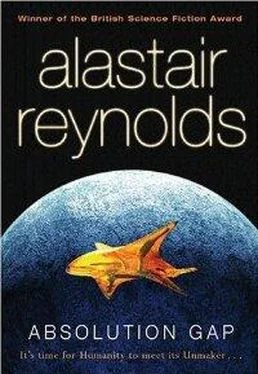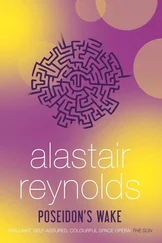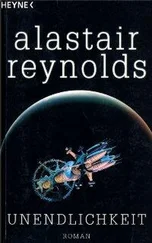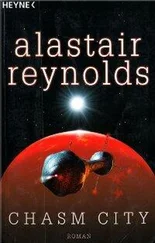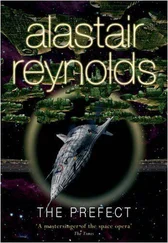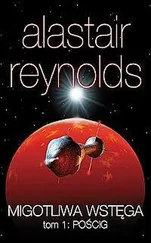He would now be amongst the eighteen thousand sleepers who were orbiting Hela.
“We have to find a way to get to those people,” he told Khouri.
“I thought we were talking about—”
“We were,” he said, leaving at it that. Let her wait a little longer: she’d waited this long, after all.
For a while, no one spoke. The cathedral looked as if it would last for another thousand years. It had, in Scorpio’s opinion, no more than five minutes left.
“I could still make it up there,” Vasko said. “If I ran… if we ran, Scorp…” He trailed off.
“Let’s go,” Scorpio said.
They all looked at him, then at the cathedral. Its front was a good seventy metres from the end of the bridge; there were still another three or four minutes before it began to push out into empty space. Then what? At least another minute, surely, before the awesome mass of the Lady Morwenna began to overbalance.
“Go where, Scorp?” Khouri asked.
“I’ve had enough,” he said, decisively. “It’s been a long day and we’ve all got a long walk ahead of us. The sooner we make a start on it, the better.”
“But the cathedral—” Rashmika said.
“I’m sure it will be very impressive. You’re welcome to tell me all about it.”
He turned around and started walking back along what remained of the bridge. The sun was low behind him, pushing his own comical shadow ahead of him. It waddled before him, swaying from side to side like a poorly worked puppet. He was colder now: it was a peculiar, intimate kind of coldness, a coldness that felt as if it had his name on it. Maybe this is it, he thought: the end of the line, just as they had always warned him. He was a pig; he shouldn’t expect the world. He’d already made more of a dent in it than most.
He walked faster. Presently, three other shadows began to loom around his. They said nothing, walking together, mindful of the difficult journey ahead of them. When, after another few minutes, the ground rumbled—as if a great fist had just struck Hela in fury—none of them paused or broke their pace. They just kept walking. And when, eventually, he saw the smallest of the shadows begin to lose its footing, he watched the others rush towards it and hold it up.
After that, he didn’t remember very much.
She issues another command and the mechanical butterflies disengage their interlaced wings, shattering the temporary screen they have formed. The butterflies reassemble themselves into the lacy, fluttering fabric of her sleeve. When she looks into the sky she sees only a handful of stars: those bright enough to shine through the moonlight and the sparkling river of the ring. Of the green star that the butterflies have revealed there is no longer any sign. But she knows it is still there, just too faint to be seen. Once revealed, it is not something that can ever be forgotten.
She knows that there is nothing actually wrong with the star. Its fusion processes have not been unbalanced; its atmospheric chemistry has not been perturbed. It shines as hot as it did a century ago, and the neutrinos spilling from its core attest to normal conditions of pressure, temperature and nucleotide abundance. But something very wrong has happened to the system that once orbited the star. Its worlds have been unmade, stripped back to raw atoms, then reassembled into a cloud of glassy bubbles: air-and-water-filled habitats, countless numbers of them. Vast mirrors—forged in the same orgy of demolition and reconstruction—trap every outgoing photon of starlight and pump it into the swarm of habitats. Nothing is wasted; nothing is squandered. In the bubbles, the sunlight feeds complex, teetering webs of closed-cycle biochemistry. Plants and animals thrive in the swarm, machines tending to their every need. People are welcome: indeed, it was people for whom the swarm was made in the first place.
But people were never asked.
This green-stained sun is not the first, nor will it be the last. There are dozens more stained suns out there. The transforming machines that make the swarms of habitats can hop from system to system with the mindless efficiency of locusts. They arrive, make copies of themselves and then they start to dismantle. All attempts to contain their spread have failed. It only takes one to start the process, although they arrive by the million.
They are called greenfly.
No one knows where they came from, or who made them. The best guess is that they are a rogue terraforming technology: something developed almost a thousand years earlier, in the centuries before the Inhibitors came. But they are obviously much more than revenant machines. They are too quick and strong for that. They are something that has spent a long time learning to survive by itself, growing fierce and feral in the process. They are something opportunistic: something that has hidden in the woodwork, waiting for its moment.
And , she thinks, we gave them that moment .
While humanity was under the heel of the Inhibitors, nothing like this outbreak could ever have been allowed to happen. The Inhibitors—themselves a form of spacefaring replicating machinery—would never have tolerated a rival. But the Inhibitors were gone now; they had not been seen for more than four hundred years. Not that they had exactly been beaten: that wasn’t how it had happened. But they had been pushed back, frontiers and buffer-zones established. Much of the galaxy, presumably, still belonged to them. But the attempt to exterminate humanity—this local cull—had failed.
It had nothing to do with human cleverness.
It had everything to do with circumstance, luck, cowardice. Collectively, the Inhibitors had been failing for millions of years. Sooner or later, an emergent species was bound to break loose. Humanity would probably not have been that species, even with the assistance from the Hades matrix. But the matrix had pointed them in the right direction. It had sent them to Hela, and there they had made the correct decision: not to invoke the shadows, but to petition the assistance of the Nestbuilders. It was they who had annihilated the scuttlers, when the scuttlers had made the mistake of negotiating with shadows.
And we almost made the same one , she thinks. They came so close that even now she turns cold at the thought of it.
The white armour of her butterflies shuffles closer.
“We should leave now,” her protector says, calling from the end of the jetty.
“You gave me an hour.”
“You’ve used most of it, stargazing.”
It doesn’t seem possible. Perhaps he’s exaggerating, or perhaps she really did spend that long picking out the green star. Sometimes she slipped into a reverie of self-remembrance, and the moments oozed into hours, the hours into decades. She is so old that sometimes she even frightens herself.
“A little longer,” she says.
The Nestbuilders (she thinks back to the earlier, now-forgotten name for the symbionts: the conch-makers) had long practised a strategy of skulking. Rather than confront the Inhibitors head-on, they preferred to slip between the stars, avoiding contact wherever possible. They were experts in stealth. But after acquiring some of their weapons and data, humanity had pursued a tactic of pure confrontation. They had cleansed local space of the Inhibitors. The Nestbuilders hadn’t liked this: they had warned of the dangers in upsetting equilibria. Some things, no matter how bad, were always better than the alternative.
This wasn’t what humanity wanted to hear.
Maybe it was all worth it , she thinks. For four hundred years we had a second Golden Age. We did wonderful things, left wonderful marks on time. We had a blast. We forgot the old legends and made better ones, new fables for new times. But all the while, something else was waiting in the woodwork. When we took the Inhibitors out of the equation, we gave greenfly its chance .
Читать дальше
